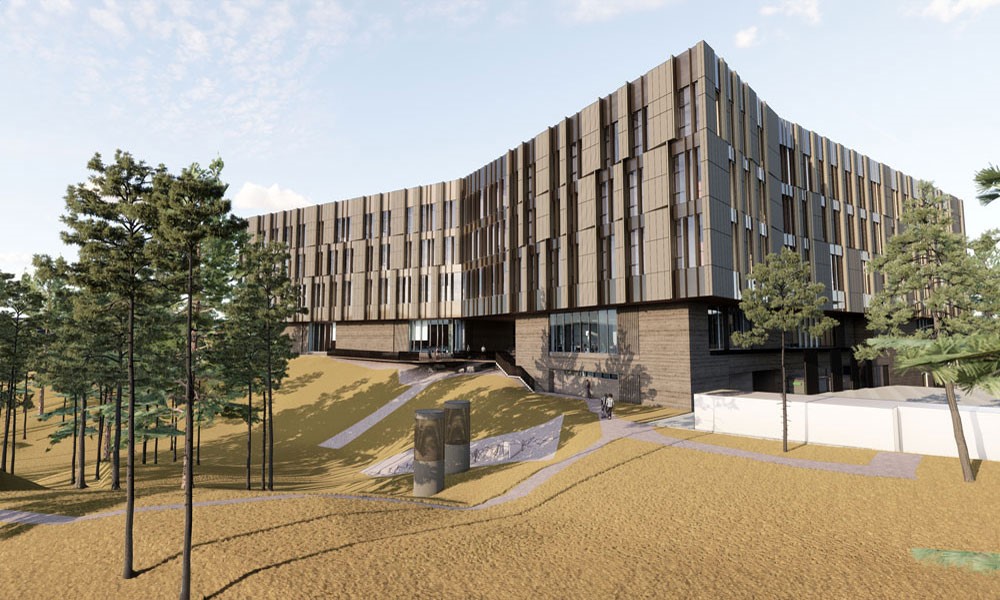From improving human health to investigating climate adaptation, research teams will tackle some of society’s most challenging problems

Artist’s rendering: UBC Okanagan’s x̌əl sic snpax̌nwixʷtn, set to open in 2026.
Solutions to some of society’s most important issues will be investigated when nine interdisciplinary research teams move into x̌əl sic snpax̌nwixʷtn, UBC Okanagan’s newest building.
Set to open in March 2026, the building will be a unique, four-story space dedicated to bringing together researchers, scholars, students and the community. It will be UBCO’s biggest platform for interdisciplinary research.
The nine interdisciplinary teams will investigate topics from immunotherapies and climate adaptation to communication and language connected to social and mental health. Teams were selected after a review process that saw applicants showcase the potential impact of their research, the importance of an interdisciplinary approach and how the new, innovative space would be used.
“There’s a wonderful cross-pollination of experts on every team,” says x̌əl sic snpax̌nwixʷtn Director of Interdisciplinarity and Operations, Natalie Rodriguez. “We prioritized teams that reflected the building’s values and ethos, and fostered the spirit of collaboration, of wanting to conduct research differently.”
An Academic Advisory Committee with representation from each of UBCO’s faculties evaluated applications, as did the building’s Academic Co-leads from the offices of the Vice-Principal Research and Innovation and the Provost and Vice-President Academic.
“Our successful teams are aligned with x̌əl sic snpax̌nwixʷtn core values of collaboration, relationality, respect, cultural sensitivity, transparency and innovation,” says Academic Co-lead and Associate Provost, Academic Affairs and Strategy, Peter Simpson. “These nine teams will form the heart of the x̌əl sic snpax̌nwixʷtn community.”
Altogether, the teams comprise nearly 120 late-, mid- and early-career researchers. In addition to the interdisciplinarity within the teams, further breaking of barriers between disciplines will be encouraged by the physical locations of research teams in the building.
In a carefully planned neighbourhood building process, teams will be located near other teams who, while they may be conducting entirely different research, may be able to benefit each other in unexpected ways.
“We’ve selected teams with members from across the entire research spectrum, from arts and humanities to STEM, and we have prioritized Indigenous ways of knowing and community practice,” says Academic Co-lead and Associate Vice Principal, Research and Innovation, Karis Shearer. “Planning the building’s research neighbourhoods provides opportunities for further collaboration and sharing of ideas. We’ve seen a real interest among teams to learn from each other.”
The design of the building has been guided by collaboration, interdisciplinarity and Indigeneity. UBC Okanagan remains committed to truth and reconciliation and, through ongoing partnership with the Syilx Okanagan Nation, x̌əl sic snpax̌nwixʷtn – an Nsyilxcn name meaning for the purpose of new innovation in a place where people work together to enlighten and inform each other – will be home to Interior Salish language fluency programs and the Centre for Contemporary Interior Salishan Studies.
Rodriguez, who began her role as director in the spring, says the building is also set to serve as an incubator where small successes have the chance to springboard to larger funding opportunities, and where long-term projects can engage with international research partners, network with other interdisciplinary centres around the world and, together, have positive impact on a global scale.
When it comes to the building’s research potential, her hopes for the future are high.
“This initiative has the chance to fundamentally change the way we conduct research, to change what we value as metrics of success,” she says. “We’re looking to better engage with communities and partners, to conduct research that matters to them and to be a model for developing a system that supports true interdisciplinarity.”
While collaboration among research teams, and building programming, is already underway, Rodriguez says she’s looking forward to the building’s completion.
“I’m eager to come together in the space as a community, to make the people and teams more aware of each other, and to live by the spirit of what it means to be in x̌əl sic snpax̌nwixʷtn,” she says. “Putting many disciplines in one building doesn’t mean you’ll have automatic collaboration, but my role as Director of Operations and Interdisciplinarity is to give them the best possible chance at success. I can’t wait to see where this goes.”